For most of us, our days rotate around our sleep time. The setting of the sun, the gathering of family around the dinner table and the clearing of plates signal the end of a long and tiring day. Many people eagerly look forward to this moment.
Several hours later, the shrill ringing of the phone alarm, the clearing sky and the welcome scent of breakfast signals the beginning of another day.
The time in between greatly defines how good your day is going to be. Poor sleep in an uncomfortable and unsupportive mattress can leave you feeling fatigued, irritable and sore all day long. A good comfortable mattress on the other hand, ensures you wake up invigorated and spend the rest of the day just as energized.
To help you get the best day, every day, we went out and looked for the best mattresses you can buy today. We specifically searched for memory foam mattresses which are known for their soft comfort and adaptive support.
If you wake up every day sore in your neck or back, not fully rested and feeling like you only slept for half the time you were in bed, it is time for a change. See our recommended memory foam mattresses below. We have also included a handy shopping guide to help you make the right pick.
Best memory foam mattress reviews
1. Leesa Mattress
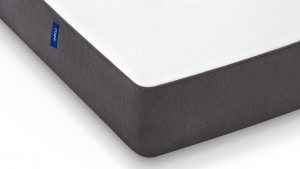 The Leesa Mattress is one of the best memory foam mattress you can buy. It consists of three layers, all working together to provide maximum comfort and support.
The Leesa Mattress is one of the best memory foam mattress you can buy. It consists of three layers, all working together to provide maximum comfort and support.
The first layer is a special type of memory foam called Avena foam. It feels bouncier than traditional memory foam but it is still as soft. So if you are looking for a memory foam mattress with some bounce, try Leesa.
The second layer uses traditional memory foam to create a nice comfortable hug. This layer contours around your body, providing even support to your upper, middle and lower body. No more waking up with tingly legs or sore shoulders.
As with most other mattresses, the final layer is dense support foam. It holds up the entire mattress and ensures it lasts years without cratering at the center. Read our full review.
Pros
- Feels more responsive (bouncy) than other memory foam mattresses.
- Really comfortable and supportive.
- Little to no motion transfer.
Cons
- Inadequate edge support.
2. Casper Mattress
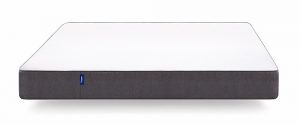 The Casper mattress has four layers, each of which is designed to fulfil a specific responsibility towards your comfort. The first layer consists of open cell foam. Its main role is creating a soft and cool surface. The open cell design allows air to flow in and out, carrying away excess heat with it.
The Casper mattress has four layers, each of which is designed to fulfil a specific responsibility towards your comfort. The first layer consists of open cell foam. Its main role is creating a soft and cool surface. The open cell design allows air to flow in and out, carrying away excess heat with it.
The second layer consists of contouring memory foam. This layer allows the mattress to curve around your body, creating a comfortable hug as you sleep. It also ensures there are no pressure points especially around areas like your shoulders, back and hips.
The third layer consisting of poly foam provides further support and weight distribution while the firm base layer is designed to provide overall support and longevity to the mattress.
Overall, the mattress is very comfortable, feels soft (but not soggy) and holds up your back and neck well. Read our full review.
Pros
- Stays cool.
- Feels plush and comfortable.
- Good support, especially for the back.
Cons
- The edges don’t have as much support as the rest of the mattress.
3. Eve Mattress
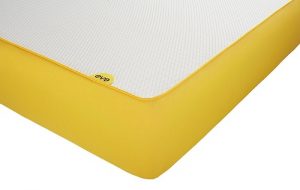 The Eve mattress looks more expensive than it really is. The stretchy cover has luxurious design with its knitted and patterned fabric.
The Eve mattress looks more expensive than it really is. The stretchy cover has luxurious design with its knitted and patterned fabric.
When you lie on the mattress, you will experience a mixture of both soft plushness and firm support. You won’t feel like you are sleeping in a swamp nor will it feel like lying on a rock.
This perfect soft-firm balance is because of the three layers used in the mattress. The first layer uses 3cm of memory foam. It is the reason why the mattress feels so plush and luxurious. It provides contouring around your body curves and angles.
The second layer uses 3cm of memory foam specially designed for cooling. This keeps the mattress from getting hot at night. The final layer is an 18cm base layer made from dense supportive foam. It keeps your mattress in shape and counterbalances the soft memory foam layers above. Read our full review.
Pros
- Nice bouncy feel.
- Stays cool through the night.
- Comfortable and supportive.
Cons
- Poor edge support.
4. Silentnight Mattress
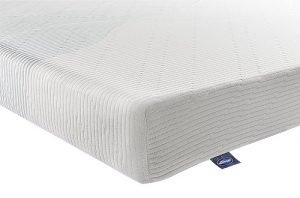 The Silentnight mattress best defines itself in its own name. A unique mattress design ensures a truly peaceful night without a painful neck, sore joints or any of the other problems caused by low quality mattresses.
The Silentnight mattress best defines itself in its own name. A unique mattress design ensures a truly peaceful night without a painful neck, sore joints or any of the other problems caused by low quality mattresses.
The design consists of three different zones covering the top, middle and lower part of the mattress. These zones correspond to your upper, middle and lower body.
The top zone uses soft foam to provide contouring and pressure relief to your neck, shoulders and upper back. The middle zone is firmer and is designed to support your lower back and hips. The bottom zone is soft to protect your knees, legs and feet from uncomfortable pressure points.
Another unique feature we love is the Purotex treated cover. This is a natural treatment that keeps allergens and moisture away from the mattress. Read our full review.
Pros
- Treated for protection against allergens.
- Special 3-zone design provides superior comfort and support.
- Firm edge support.
Cons
- Relatively short warranty compared to other mattresses.
5. Simba Hybrid Mattress
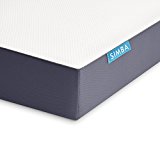 Compact on arrival, extremely comfortable, unmatched response time and quite the quality craftsmanship, the the Simba Hybrid Mattress claims to be the most advanced mattress on the planet.
Compact on arrival, extremely comfortable, unmatched response time and quite the quality craftsmanship, the the Simba Hybrid Mattress claims to be the most advanced mattress on the planet.
The manufacturer used every available sleeping technology to provide you with the ultimate sleeping experience. This unique mattress incorporates latex, memory foam, pocket springs and poly foam to create a winning combination of comfort and support.
In addition to moulding perfectly to your body shape, the mattress also allows two people with different sleeping patterns to sleep comfortably without disrupting each other.
The Simba Hybrid Mattress fits all bases, is safe for everyone and comes with a 100 night guarantee with the option of a full refund. Read our full review.
Pros
- High quality, unique combination of materials
- Fits almost every type of base or platform
- Sturdy foundation base with 7 support zones
Cons
- Be prepared to shell out a pretty pound for the mattress
How to buy the best memory foam mattress
The most important bit when buying a new mattress is knowing what to look for. Too many mattress sellers love to confuse buyers with useless bells and whistles. They’ll mention a dizzying number of supposedly great features to tempt you.
More often than not, these complicated mattresses have the least value for money. If you look at each of our top mattress picks, you’ll notice they have a simple design with an average of three layers. Any innovative feature added – such as the zoned design of the Silentnight mattress – actually improves the sleeping experience by making the mattress cooler, more comfortable or more supportive.
So the greatest danger when choosing a mattress is falling for expensive but unnecessary gimmicks. To help you pick the best memory foam mattress for your needs, here are the most important considerations to keep in mind.
1. Support and comfort
Support is the most important aspect in a mattress. It determines how comfortable the mattress is and the quality of sleep you get.
A mattress with inadequate support will not only cause you to sleep poorly, it can have adverse effects on your health, specifically your joints, muscles and spinal cord. The health effects can be especially harmful if you are suffering from chronic conditions affecting your back, joints or muscles such as arthritis.
A good mattress should provide even support to your whole body. This includes proper alignment of the spinal cord and contouring around protruding areas such as the shoulders and hips to protect against excessive pressure.
You can easily find out if your current mattress is not supportive. You will frequently wake up with soreness or pain somewhere in your body usually the back, neck or legs. You will also feel as if you are not getting enough sleep despite sleeping a solid 7-8 hours.
Sometimes you may not know just how bad the mattress was until you try a new one that’s well designed for full support. When assessing the support and comfort of a certain mattress take note of the material used, the firmness level of the mattress and what customers are saying.
For instance some all-memory foam mattresses tend to be too soft, which translates into less support. They have an uncomfortable swampy feeling. That’s why most brands will combine memory foam with other firmer types of foam.
As for the firmness level, this will vary from person to person. Most mattresses are medium firm, neither too soft nor too firm. They are the best for most people including back, stomach and side sleepers.
If your weight is on the higher side, consider getting a firm mattress for best support. If you are slim, a softer mattress may be more comfortable and better for your sharp bones and joints.
2. Temperature control
A few years ago, not many mattresses paid attention to the issue of heating. Many people complained that their mattresses got hot at night.
In recent years, I have seen companies incorporate a number of technologies to combat this problem. Some brands mix the foam with gel which is good at conducting heat away from the mattress.
But the most common strategy is to use foam that allows air circulation. Open cell foam is a good example. Air circulates in and out of the mattress, carrying away trapped heat and moisture.
A mattress that stays cool is a mattress that stays fresh too. This is because there is no trapped air and moisture within the foam that could cause stale smells.
The temperature control issue is a big deal for a lot of people. So much so that a whole new industry dealing with mattress cooling pads has sprung up. But instead of spending extra money to make your nights cooler, get a mattress that has already been designed to stay cool.
Look for technologies such as gel-infused foam or open cell foam. It is also worth looking at customer reviews to learn people’s personal experiences.
3. Longevity
A good mattress should last for at least a decade with normal use. Considering that you going to spend several hundred dollars or even over a thousand dollars on a mattress, constantly buying new ones is going to be pricey.
You have two options here. One, buy a cheap, low quality mattress and then replace it 3 or 4 times within a decade. Two, invest in a more expensive but quality mattress that will last for 10 years or more and save you money.
The design and structure of a mattress can give you a hint of how long it will last. One thing to look for is a dense foundational layer, usually the thickest layer at the bottom of the mattress. The base plays a big role in the durability of the mattress, preventing it from losing shape or sagging after just a couple of years.
Don’t forget to check customer reviews for comments on how well the mattress holds up over time. Does it lose support? Does the cover get frayed?
Note that the mattress’ longevity will also depend a lot on how you use it. Most companies recommend using a stable and rigid base to keep the mattress in shape. You might also want to get a mattress protector to protect against stains and dirt.
4. Warranty
The warranty is a good indicator of the lifespan of a mattress. It can give confidence when you are buying from a new brand (such as Leesa or Casper) that has not had a chance to get the test of time with users.
Most mattress companies have a 10 year warranty though the exact nature of the warranty may vary from one brand to the other. For example some have a prorated warranty where you may be required to pay a certain amount of money to get a replacement depending on the age of the mattress.
Some pricier mattresses can have a warranty extending for 15 and even 20 years.
Frequently asked questions
Q: Is a mattress with more layers better?
Not necessarily. What matters is not the number of layers but what those layers are made from and what they do. In fact in some cases, more layers can obstruct air flow and cause a mattress to get hot and smell stale.
Q: How do I know what firmness level is best for me?
The best firmness level will depend on your needs and sleeping preferences. Some people like a firm mattress while other like it soft. Back and stomach sleepers need a slightly firmer mattress while side sleepers need a soft-foamed mattress.
If you are not sure, get a medium firm mattress. In any case, I’m sure you can make a return if the firmness level is not comfortable.
Q: Some people say that new mattresses release toxic gasses. Should I be worried?
Not at all. Most mattresses adhere to strict manufacturing standards such as CertiPUR to ensure their products are safe and do not contain any harmful substances. The smell that is released when you open a new mattress is like that of a new car. It is the smell of freshly manufactured foam.
If it bothers you, leave the mattress to air for a few days before covering it with bedding.
Q: How to clean a memory foam mattress
Check if the mattress cover is removable and washable. If it is, unzip it and clean it in the washer, making sure to follow the manufacturer’s cleaning instructions.
If the mattress cover cannot be washed, the best way to clean stains and spots of it is by spot cleaning. Mix cold water and a gentle detergent, dip a clean cloth into it and dab gently at the spot. Leave the mattress uncovered to dry the wet spot.
To remove crumbs, lint and dirt particles off the mattress, use a vacuum cleaner with an upholstery attachment.
To freshen up the entire mattress, mix a half cup white vinegar or fabric cleaner with one cup water in a spray bottle. Spray the mattress lightly, being careful not to dampen it. Leave the mattress uncovered until it dries.
Baking soda is also great for deodorising a memory foam mattress. Sprinkle baking soda all over the bed and let it sit for a couple hours before vacuuming the mattress.
To keep the mattress from getting too dirty, get a waterproof mattress protector. It’ll keep out moisture, stains, dirt and allergens. Not only will it keep your mattress clean, it’ll ensure it lasts longer.
Q: How long does a memory foam mattress last?
The average lifespan of a memory foam mattress is 8-10 years.
But this can vary depending on the foam quality and build quality of the mattress. High-density memory foam typically lasts longer while cheap low-density memory foam mattress may not last beyond 5 years.
The thickness of the mattress also matters. A luxury 12”-14” memory foam mattress can last well over 10 years without sagging.
Using the right foundation and taking proper care of the mattress will increase its lifespan.
Q: How long does a memory foam mattress take to expand?
If you ordered a bed-in-a-box mattress, it’ll take about 3-6 hours (after you’ve laid it out on the bed) to expand enough that you can sleep on it.
But it can take a day or two for it to fully expand to the manufacturer-specified thickness.
